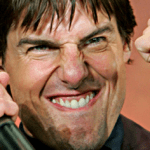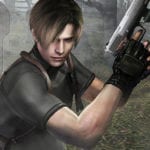 Weird Stuff
Weird Stuff  Weird Stuff
Weird Stuff  Our World
Our World 10 Ways Your Christmas Tree Is More Lit Than You Think
 Movies and TV
Movies and TV The 10 Coolest Stars to Set Sail on The Love Boat
 History
History 10 Things You Didn’t Know About the American National Anthem
 Technology
Technology Top 10 Everyday Tech Buzzwords That Hide a Darker Past
 Humans
Humans 10 Everyday Human Behaviors That Are Actually Survival Instincts
 Animals
Animals 10 Animals That Humiliated and Harmed Historical Leaders
 History
History 10 Most Influential Protests in Modern History
 Creepy
Creepy 10 More Representations of Death from Myth, Legend, and Folktale
 Technology
Technology 10 Scientific Breakthroughs of 2025 That’ll Change Everything
 Weird Stuff
Weird Stuff Ten Bizarre Facts About The Doge Meme
 Our World
Our World 10 Ways Your Christmas Tree Is More Lit Than You Think
 Movies and TV
Movies and TV The 10 Coolest Stars to Set Sail on The Love Boat
Who's Behind Listverse?

Jamie Frater
Head Editor
Jamie founded Listverse due to an insatiable desire to share fascinating, obscure, and bizarre facts. He has been a guest speaker on numerous national radio and television stations and is a five time published author.
More About Us History
History 10 Things You Didn’t Know About the American National Anthem
 Technology
Technology Top 10 Everyday Tech Buzzwords That Hide a Darker Past
 Humans
Humans 10 Everyday Human Behaviors That Are Actually Survival Instincts
 Animals
Animals 10 Animals That Humiliated and Harmed Historical Leaders
 History
History 10 Most Influential Protests in Modern History
 Creepy
Creepy 10 More Representations of Death from Myth, Legend, and Folktale
 Technology
Technology 10 Scientific Breakthroughs of 2025 That’ll Change Everything
10 Quirky Armies Of Pint-Sized Nations
The phrase “national army” conjures up a pretty standard image: a large, imposing, and professional fighting force. And if we’re familiar with a modern army at all, it’s probably one of the big ones, e.g. China, Germany, the United States, etc. Yet there are some armies that don’t fit the mold.
We might expect the tiny nations of the world to opt out of militaries altogether—and some, like Liechtenstein, have done so. But the act of defending oneself (even symbolically) carries with it much pride, honor, and sense of national sovereignty. For this reason, most little countries have some token military force, even if the big countries could steamroll them practically by accident. For fun-sized feistiness, look no further than these militaries in miniature . . .
10 San Marino—Fun-Sized Finery

When Italy unified in the 19th century, the unifiers went around collecting provinces and principalities like an overzealous kid at an Easter egg hunt. But it turns out they let one be: San Marino, the last of the old Italian city-states. In its little pocket along the Adriatic Sea, the country is surrounded on three sides by Italy. Unsurprisingly, international agreements have Italy responsible for wartime protection of its petite cousin. However, the inhabitants (called Sammarinese) do maintain a small army of their own. And like an Easter egg, the Sammarinese military is tiny, fragile, and resplendent.[1]
Each branch has its own distinctive uniform. The Guard of the Rock, combination border patrol and police detectives, wear a vibrant double-breasted green coat with bright red pants. A national defense force, the Company of Uniformed Militia, carries muskets and swords to go with their dark blue uniforms and white sashes and epaulets. San Marino’s governing body, the Grand and General Council, save the most splendidly-garbed soldiers for their own protection. The Guard of the Council is attired in a dark blue tailcoat with gold edging and epaulets, white gloves, and cocked hats with an elaborate plume of blue and white feathers. They understandably feature in a high percentage of San Marino postcards.
Last, but not least, is the Crossbow Corps. In the 1300s, when crossbows were the cutting edge of military technology, this group formed the centerpiece of Sammarinese forces. Obviously, that can no longer be the case. But San Marino’s people care about legacies, and the 70-person corps of volunteers maintains this one with gusto. The uniforms are thoroughly medieval, with tunics and puffy felt hats.
Lest you think they can be ridiculed like garden-variety Renaissance fair staff, though, be advised: The Corps trains rigorously with its crossbows to this day. And they are excellent marksmen!
9 Seychelles—The Afterthought Army

Since small populations mean small armies, you might guess that Seychelles, an African nation of only 94,000 people, would have a tiny military. You’d be correct. But you might not have guessed that Seychelles’s armed forces are almost entirely concentrated in its navy.
That’s because Seychelles is an archipelago. Those 94,000 people are spread across 115 islands; the low land area is one major reason the population isn’t higher. In this environment, a large land force would have to call their naval brethren for a ride almost every time they tried to move. The people of Seychelles just decided to put their efforts into the most vital branch.[2]
Officially termed the Coast Guard, it holds the vast majority of Seychelles’s 650 servicemen and women. And, for its size, it’s decently equipped: The three patrol boats and four gunboats provide adequate coverage for the nation’s many miles of coastline. Their aquatic mobility gives them the capacity to project force wherever it is needed. The Coast Guard’s duties even extended to protecting the privacy of Prince William and Princess Kate of the United Kingdom during their honeymoon in May 2011.
Seychelles’s other branches are neglected stepchildren by comparison. The Air Force has a grand total of four aircraft, none of which are combat-capable. Any leftover budget goes to the ground forces, many of whom are tied down as presidential bodyguards.
Even the third-string army has had its time to shine, however. In 1981, the force successfully contained and drove off a group of foreign mercenaries who, while posing as a vacationing beer club, briefly seized the main airport in a coup attempt. The Seychelles People’s Defence Forces benefited from the attack—not only in practical experience but in confidence. The soldiers grew more self-assured after their success, and the one man killed in action became a moral rallying point for the rest of the force.
8 St. Kitts And Nevis—On-Again, Off-Again
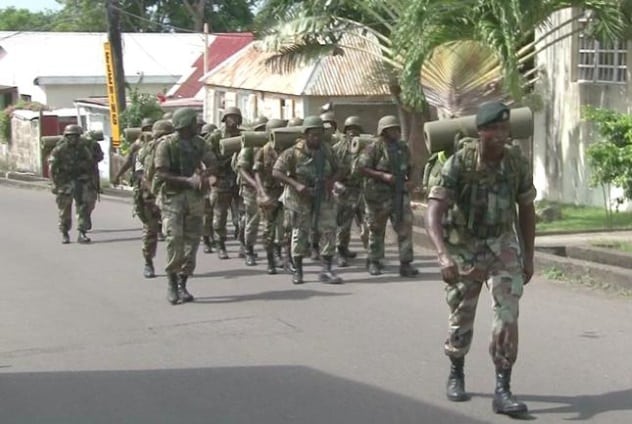
Even a small army is a big expense. It’s understandable that wee, cash-strapped nations might choose to go without, but this must be balanced against the also understandable desire to maintain one’s own protection. With such a contentious issue at stake, democratic shifts in government can result in an odd flip-flopping. Such is the case in the Caribbean nation of St. Kitts and Nevis—where the army flickers in and out of existence like a faulty light bulb.
Another island nation, St. Kitts and Nevis is the newest sovereign state in North America, gaining independence from the United Kingdom only in the late 20th century. With independence came the need for decision-making. One party argued the need for an army; another violently opposed it. The majority ruled, leading to the creation of a professional army (formally the Defence Force) in 1967. After the opposition took power, they dissolved the regular army in 1981, leaving only a small reserve force. And in 1997, when the previous party regained control, the army was commissioned once again.
In its current incarnation, the 350-person-strong Defence Force consists of the Coast Guard and an infantry regiment. The five-vessel Coast Guard helps intercept drug traffickers; the fighting strength of the infantry consists of a mere three rifle platoons.[3] This strength can be swelled by some reserves and the 150 members of the Cadet Corps. In times of great crisis, these other personnel can be called into active service—as long as they don’t report for duty to find that the army’s been disbanded again!
7 Cape Verde—The Drug-Busters
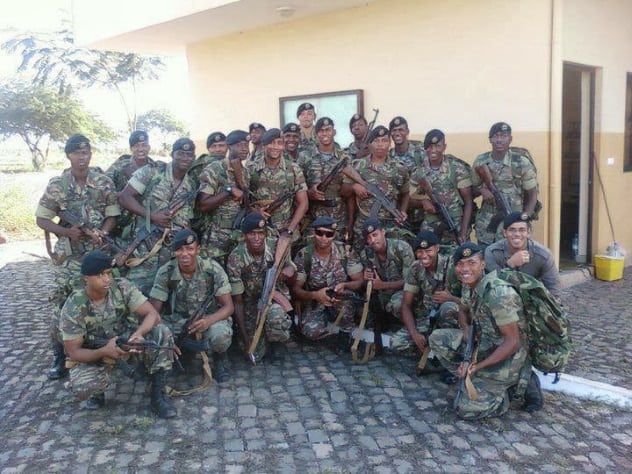
It’s common to say that certain people or groups have more money or power than some nations—a statement many will find humorous precisely because it’s true. But what happens when one of the powerful groups has a showdown with one of the little nations? That’s exactly what occurred when tiny Cape Verde, an island nation off the coast of West Africa, used its army to take on a powerful drug cartel.
The little republic has been independent from Portugal since the 1970s. In that decade, the force formerly agitating for independence (the Forcas Armadas Revolucionarias do Povo, with the unfortunate acronym FARP) became the country’s army. Known today as the National Guard, it contains about 1,200 personnel. A great many of them were drawn into Operation Flying Launch, a four-year operation that pitted the country’s armed forces and police in a joint fight with powerful drug smugglers.[4]
Cape Verde’s location in the Central Atlantic makes it an ideal stopover for cocaine on its way from South America to Europe. Verdean police and soldiers worked undercover for two years, laying the groundwork for massive seizures of drugs, cash, and real estate. They pulled the trigger in 2011, dismantling one potent gang in the process. It took a massive, coordinated effort by the combined forces of the entire nation, but they did it.
Sadly, troubles remain for the little country. Angry drug traffickers have struck back in recent years with a series of assassination attempts. And in 2016, one disaffected National Guard soldier went on a shooting rampage in a barracks, killing eight of his fellow soldiers. Because of the military’s small size, these few minutes of rage wiped out 0.6 percent of Cape Verde’s servicemen in a single blow.
6 Malta—Playing Armaments Bingo

The island of Malta, with its population of less than 450,000, supports a total of a little under 2,000 military personnel. These personnel are homegrown, for the most part, but the same cannot be said for their arms and munitions. Without a native arms industry, Malta must rely on what it can buy (or beg) from foreign countries. In this, its experience mirrors that of many of the world’s smaller states.
It turns out many bigger nations are eager to help. Since Malta forms the southern border of the European Union, EU states have a vested interest in keeping the border secure. For goodwill and/or profit, countries as diverse as the US and China have shipped their wares to Malta. All of this has resulted in a steady stream of weaponry into the country, much of it donated.
The only problem? None of it matches.
It’s far from a mere aesthetics issue. Units in which every soldier has a unique weapon might play well in Hollywood, but they make ordnance officers (tasked with keeping replacement parts and usable ammunition on hand) tear their hair out in frustration. Electronics have to be compatible with each other, or they quickly become very expensive paperweights. And all these problems multiply when maintaining armored vehicles, naval vessels, or aircraft. Standardization is a never-ending nightmare for the Maltese.[5] They do the best they can.
With its hodgepodge of armament, the Armed Forces of Malta (AFM) perform a similar hodgepodge of duties. In addition to the obvious—combat readiness, border patrol, and antiterrorism operations—AFM forces also deal with medical evacuations, monetary transport, airport security, and even postal protection. The small island hasn’t forgotten its international obligations, either. Despite their small size and frugality, the AFM keeps a Quick Reaction Force constantly ready to deploy for United Nations and other international missions across the globe.
5 Monaco—We Few, We Overworked Few

The Principality of Monaco, the world’s second-smallest country, is best known for its fabulous casino at Monte Carlo. That casino, with close ties to the government and royal family, brings the country enormous wealth disproportionate to its size—one third of Monaco’s residents are either millionaires or billionaires. Little of that wealth goes to funding the country’s military, however. The microscopic force could easily be swallowed up unnoticed by the crowds in the casino.
The military is divided into two units, the Prince’s Carabiniers and the Corps des Sapeurs-Pompiers (Corps of Firemen). The former unit, with a total strength of about 116, is charged with protecting the prince of Monaco and his palace. The latter, at a whopping 135 personnel, handles both military and civil service duties. Combined, they give the principality a total strength of about 251, divided into 15 possible ranks. It would be tempting to say that the Monegasque armed forces have more generals than privates—but that can’t be true, since Monaco’s forces have no rank higher than colonel.[6]
Implausibly, Monaco’s fighting personnel take on even more duties than the plethora undertaken by those in Malta. The Corps of Firemen respond to fire alarms, serve as paramedics, perform search and rescue, and undertake hazardous material cleanup. And the Carabiniers, in addition to guarding the prince and judiciary, maintain motorcycle escorts, additional ambulance services, scuba divers, a brass ensemble, trumpeters, a marching band, and a fully functional orchestra. It’s unclear how many of these units are staffed simultaneously by the same people.
It’s also unclear if the members of Monaco’s military ever sleep!
4 The Vatican—A Smattering Of Swiss

Back when the pope of the Roman Catholic Church controlled substantial land holdings—the Papal States—he had a substantial military to go with it. When his lands were diminished, thanks to the same Italian unifiers mentioned previously, his armed forces shrank as well. The last territorial remnant is the Vatican City State, the world’s smallest sovereign country (at 110 acres in size). Its de facto army is the 100-man Pontifical Swiss Guard.
The Guard’s main role is to protect the pope, though this naturally extends to protection of his residence and of Vatican City as a whole. Its long history makes it one of the oldest continuously operating military units in the world. That history contains both proud moments and weak ones. The Guard traveled to fight in the watershed naval Battle of Lepanto against the Turks, and one contingent fought to the death to keep the pope out of the hands of rampaging German troops in 1527. However, by the 19th century, the Guard had grown lax, slovenly, and almost entirely ceremonial.
An energetic officer in the 20th century reversed this trend. As commander of the Guard, he redesigned its ceremonial uniform (a 154-piece ensemble including shirts and pantaloons in blue, red, and yellow, plate armor, a dark blue cape, and a steel helm with red, white, yellow and black, and purple ostrich plumes) and its equipment (halberds, great swords, and rapiers) to reflect its Renaissance lineage. There are a few nods to modernity, though. Nowadays, Swiss guardsmen in plain clothes always escort the pope and maintain pistols, rifles, and submachine guns for contingencies.[7]
The Guard also has strict criteria for membership. Each guardsman must be a single male Swiss citizen between the ages of 19 and 30, at least 174 centimeters tall (5’9″), have completed the Swiss Army’s basic training program, and be able to be certified for good conduct. And, naturally, they have to be Catholic.
3 The Comoros—Outnumbered By The Police

The Union of the Comoros, a three-island nation between Madagascar and mainland Africa, has a population of almost 800,000. That number would suggest the possibility of an armed force of decent size, but the suggestion would be a false one. Its tiny standing army is dwarfed by the 500 members of its police service (though army reserves make the total available force slightly larger).
One reason for the army’s small size is the Comoros’s instability. A complex political system has each island operating semiautonomously, with separate constitutions and presidents. The island presidents rotate through four-year terms as president of the overall nation—in theory. In practice, the complicated political machinery is prone to breaking down. The nation’s history is cluttered with coups, attempted coups, and assassinations; though the Comoros became independent from France in 1975, it did not have a peaceful transfer of power until 2006. With multiple factions vying for power, a large army could prove an irresistible tool for aspiring dictators. The army the nation does have is divided between multiple reporting authorities, just to break up the available power base.[8]
800,000 people need a sizable amount of policing, though. Therefore, the Comoros gets a lot of police and much fewer regular troops. The disparity even extends to the country’s air forces: The air Security Force has only four aircraft, while the police have six.
All this doesn’t keep the Comorians from mixing it up militarily when the need is great. After that exemplary transfer of power in 2006, a sticky situation arose in 2007, when the president of the island of Anjouan refused to step down after a contested election. The other two islands mustered the national force and made an amphibious landing on Anjouan, supported by allied troops from the African Union.
The obstinate president had gathered his own private army several hundred strong—enough to make serious trouble for the small invasion force. However, most of his troops deserted him when the conflict began, and the tiny Comorian military restored order without taking a single casualty.
2 Grenada—SWAT Team Stand-Ins
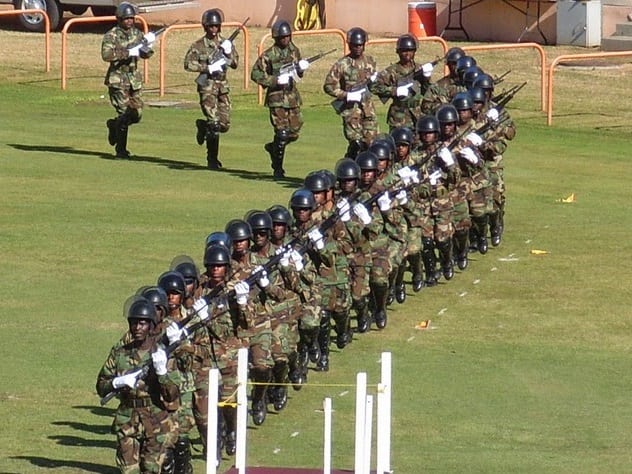
Grenada is yet another archipelago nation, consisting of seven islands in the Caribbean. Readers alive in the 1980s may remember it as having a brief, dramatic conflict in during one of the hotter periods of the Cold War. The Grenadian Army was a force to be reckoned with at that time; after a Communist-backed military coup, US and allied forces geared up for a potentially costly invasion in 1983. As it happened, the fighting flared up like a match and burned out again just as quickly. After a few days’ shooting and a few hundred casualties between the two sides, the invading force restored a friendly regime to power and dismantled the existing military structure.
In its place was left a nation trying to move beyond its militaristic past. The only armed services supported by the government are a 30-member Coast Guard and a 800-member police department. Realistically, the only personnel available for national defense are the 80 members of the police force’s paramilitary Special Services Unit (SSU). If they fanned out to protect every island, these paramilitary troops could muster little more than ten personnel apiece.[9]
Thankfully, there is low risk of that being necessary. Grenada works with surrounding powers for defense and trains its forces with US military assistance. In keeping with the peaceful bent of recent Grenadian history, the SSU these days is more in the business of destroying weapons than employing them. In 2013, the unit publicly destroyed more than 140 guns from its armory, most of which had been sitting there for decades.
1 Andorra—The Dependable Dozen

Andorra is a flyspeck mountain nation perched in the Pyrenees between France and Spain. Within its population of almost 80,000 lies the paper strength of its armed forces: In times of need, all native men between 21 and 60 must report and serve in the national army. For this reason, all households are instructed to maintain a rifle, and police keep additional weapons on hand to arm the populace as necessary. Thus, the theoretical military might of Andorra runs into the thousands.
That’s the theory. Things are much more modest in practice. Andorra’s permanent standing army amounts to 12—and there’s not a private among them.
The permanent force consists exclusively of officers and noncommissioned officers, since all lower ranks in times of war would come from the general population. The majority of the army is its corporals, who are each charged with raising troops in one of the nation’s parishes when the need arises. Since the need has never arisen in modern times, the army’s day-to-day life is purely ceremonial—most often appearing at official events to present the flag.[10] The force’s entire budget comes from voluntary donations.
Being so shorthanded, Andorra’s military sometimes lets things slip through the cracks (as when the country inadvertently remained at war with Germany from 1914 to 1958, because no one remembered to declare peace). They do their job to their best of their ability. Still, it’s intriguing to consider a nation whose entire military manpower could fit comfortably on an airport shuttle. That would certainly be very efficient. The only downside is that, should the shuttle get stuck in traffic, the nation would be left defenseless!
Small as it is, the Andorran force would be hard-pressed to serve as even a speed bump to a hostile nation. Yet they remain steadfast. Like all the national forces on this list, they exemplify the fact that overpowering strength is not a prerequisite for devotion to duty.
David Ellrod lives in Maryland with his wife, three children, and one very excitable dog.
For more military wackiness, check out 10 Unintentionally Hilarious Military Incidents and 10 Goofball Military Antics That Went Way Too Far.



